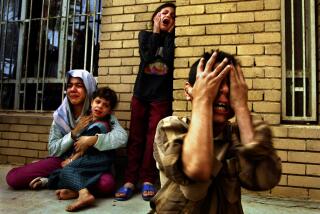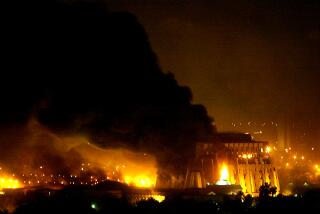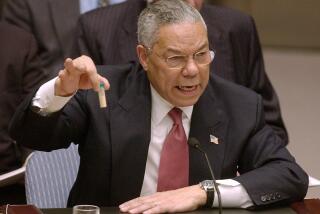The Lies We Are Told About Iraq
- Share via
OAKLAND — The Bush administration’s confrontation with Iraq is as much a contest of credibility as it is of military force. Washington claims that Baghdad harbors ambitions of aggression, continues to develop and stockpile weapons of mass destruction and maintains ties to Al Qaeda. Lacking solid evidence, the public must weigh Saddam Hussein’s penchant for lies against the administration’s own record. Based on recent history, that’s not an easy choice.
The first Bush administration, which featured Dick Cheney, Paul D. Wolfowitz and Colin L. Powell at the Pentagon, systematically misrepresented the cause of Iraq’s invasion of Kuwait, the nature of Iraq’s conduct in Kuwait and the cost of the Persian Gulf War. Like the second Bush administration, it cynically used the confrontation to justify a more expansive and militaristic foreign policy in the post-Vietnam era.
When Iraqi troops invaded Kuwait on Aug. 2, 1990, the first President Bush likened it to Nazi Germany’s occupation of the Rhineland. “If history teaches us anything, it is that we must resist aggression or it will destroy our freedoms,” he declared. The administration leaked reports that tens of thousands of Iraqi troops were massing on the border of Saudi Arabia in preparation for an invasion of the world’s major oil fields. The globe’s industrial economies would be held hostage if Iraq succeeded.
The reality was different. Two Soviet satellite photos obtained by the St. Petersburg Times raised questions about such a buildup of Iraqi troops. Neither the CIA nor the Pentagon’s Defense Intelligence Agency viewed an Iraqi attack on Saudi Arabia as probable. The administration’s estimate of Iraqi troop strength was also grossly exaggerated. After the war, Newsday’s Susan Sachs called Iraq the “phantom enemy”: “The bulk of the mighty Iraqi army, said to number more than 500,000 in Kuwait and southern Iraq, couldn’t be found.”
Students of the Gulf War largely agree that Hussein’s invasion of Kuwait was primarily motivated by specific historical grievances, not by Hitler-style ambitions. Like most Iraqi rulers before him, Hussein refused to accept borders drawn by Britain after World War I that virtually cut Iraq off from the Gulf. Iraq also chafed at Kuwait’s demand that Iraq repay loans made to it during the Iran-Iraq war in the 1980s.
Administration officials seemed to understand all this. In July 1990, U.S. Ambassador to Baghdad April Glaspie told Hussein that Washington had “no opinion on Arab-Arab conflicts, like your border disagreement with Kuwait,” a statement she later regretted.
The National Security Council’s first meeting after Iraq’s invasion of Kuwait was equally low key. As one participant reportedly put it, the attitude was, “Hey, too bad about Kuwait, but it’s just a gas station -- and who cares whether the sign says Sinclair or Exxon?”
But administration hawks, led by Cheney, saw a huge opportunity to capitalize on Iraq’s move against Kuwait. The elder Bush publicly pronounced, “a line has been drawn in the sand,” and he called for a “new world order ... free from the threat of terror.” His unstated premise, as noted by National Security Advisor Brent Scowcroft, was that the United States “henceforth would be obligated to lead the world community to an unprecedented degree” as it attempted “to pursue our national interests.”
The administration realized that a peaceful solution to the crisis would undercut its grand ambitions. The White House torpedoed diplomatic initiatives to end the crisis, including a compromise, crafted by Arab leaders, to let Iraq annex a small slice of Kuwait and withdraw. To justify war with Hussein, the Bush administration condoned a propaganda campaign on Iraqi atrocities in Kuwait. Americans were riveted by a 15-year-old Kuwaiti so-called refugee’s eyewitness accounts of Iraqi soldiers yanking newborn babies out of hospital incubators in Kuwait, leaving them on a cold floor to die.
The public didn’t know that the eyewitness was the daughter of Kuwait’s ambassador to the United States, and that her congressional testimony was reportedly arranged by public relations firm Hill & Knowlton and paid for by Kuwait as part of its campaign to bring the United States into war.
To this day, most people regard Operation Desert Storm as remarkably clean, marked by the expert use of precision weapons to minimize “collateral damage.” While American TV repeatedly broadcast pictures of cruise missiles homing in on their targets, the Pentagon quietly went about a campaign of carpet bombing. Of the 142,000 tons of bombs dropped on Iraq and Kuwait in 43 days, only about 8% were of the “smart” variety.
The indiscriminate targeting of Iraq’s civilian infrastructure left the country in ruins. A United Nations mission in March 1991 described the allied bombing of Iraq as “near apocalyptic” and said it threatened to reduce “a rather highly urbanized and mechanized society ... to a preindustrial age.” Officially, the U.S. military listed only 79 American soldiers killed in action, plus 59 members of allied forces.
A subsequent demographic study by the U.S. Census Bureau concluded that Iraq probably suffered 145,000 dead -- 40,000 military and 5,000 civilian deaths during the war and 100,000 postwar deaths because of violence and health conditions. The war also produced more than 5 million refugees. Subsequent sanctions were estimated to have killed more than half a million Iraqi children, according to the U.N. Food and Agriculture Organization and other international bodies.
The Gulf War amply demonstrated the merit of two adages: “War is hell” and “Truth is the first casualty.” To date, nothing suggests that a second Gulf War would prove any less costly to truth or humans.
More to Read
Sign up for Essential California
The most important California stories and recommendations in your inbox every morning.
You may occasionally receive promotional content from the Los Angeles Times.













